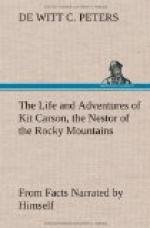Soon after the two volunteers came in, Fremont resumed his journey and continued it without anything transpiring to disturb the equanimity of the party until they reached a point on the Virgin River where the Spanish Trail leaves it. It became necessary to change camps here, in order that the animals might take advantage of better grass. As the party were enjoying a day’s rest, one of the men, a Canadian by birth, missed his riding mule from the herd. Without informing any of his friends of his intentions, he started out in quest of the animal. His absence, at first, was not noticed; but, soon, inquiries were made for him, and when an unusual length of time had passed without his return, Fremont became anxious for his safety. He directed Kit Carson to take three men and go in search of him. On arriving at their last camp, Kit found a spot where, undoubtedly, the man had fallen from his horse wounded, as, about the place, there were pools of coagulated blood. It was now believed that their companion was dead. Kit immediately ordered the party to search for his body, but they could not find it. They then followed the trail of the Canadian’s horse, which it was very evident he had caught and mounted before being shot. It led to where the animal had crossed the river. There, all signs disappeared. After a faithful search for the trail, Kit returned to camp, and informed his commander of the result of his day’s work. The next morning the search was renewed by all of the company. They discovered Indian signs, yet could not trace them to where the body was. After looking in every conceivable hiding-place in the neighborhood of the signs, they gave up the hunt. Kit Carson was much affected by the loss of this man. He had been his friend. They had been associated in many trapping expeditions, and knew each other most intimately. He felt assured that, if the Canadian had not been surprised by any enemy in ambuscade, he would have killed one or two Indians before he himself fell; for, besides being a very brave man, he was well versed in Indian mode of warfare, and was considered a fine marksman.
The party now proceeded on their journey, returning to and keeping on the Spanish Trail, which was not left until they reached the “Vega of Santa Clara.” There they struck out across the country to the Utah lake, which, after crossing, they left, and went to the Wintry River, and thence to Green River, Brown’s Hole, Little Snake River, and so on to the mouth of St. Vrain’s Fork. It was here that they traversed the mountains and came upon Laramie River below the New Park. They journeyed through this into the Old Park, and thence traveled to the head waters of the south fork of the Platte. On quitting it, they bent their way to the Arkansas River, coming on to it at a point just below the place where it leaves the Rocky Mountains; and, by keeping on down it, they arrived at Bent’s Fort on the 2d of July, 1844. On the following fourth of July Mr. Bent gave a dinner in commemoration of the occasion to Fremont and his party. Although hundreds of miles separated from their countrymen, yet they sat down to as sumptuous a repast as could be furnished in many towns of the States.




